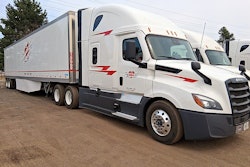A 25% tariff on imported vehicles and specific vehicle components set to take effect Thursday could impact one-third of U.S. commercial vehicle sales, according to a report by S&P Global Mobility.
Since taking office in January, President Donald Trump has increased tariffs on China by 20%, enacted narrow 25% tariffs on Canada and Mexico, and boosted tariffs on steel and aluminum to 25% – duties on more than $1 trillion of imports.
Along with swift retaliatory measures from Canada and Mexico, S&P anticipates that more tariffs targeting vehicle imports could potentially reduce short-term trucking demand and, over time, reshape the landscape of commercial vehicle manufacturing.
Some manufacturers are more exposed to potential disruptions than others. According to S&P, nearly a third of new Class 4-8 trucks sold in the U.S. are imported from Canada and Mexico, with more than 40% of Class 8 trucks coming from those countries.
While manufacturers consider typical cost-cutting measures, Andrej Divis, executive director of global truck research at S&P Global Mobility, said they could also be reoptimizing or rebalancing production between manufacturing in Canada and Mexico.
U.S. commercial vehicle suppliers have “little or no” capacity to absorb a 25% increase, according to S&P. Meanwhile, most big-bore engines are manufactured in the U.S. before being shipped to Canada or Mexico for vehicle installation. The report, which also includes motorcoaches and RVs, warned that while the full impact across the supply chain is difficult to quantify, price increases for U.S. commercial vehicle buyers are likely if the tariffs take effect.
American Trucking Associations President and CEO Chris Spear estimated the price of a new tariffed tractor could increase by as much as $35,000. S&P estimates that the net impact of tariffs on new U.S. truck prices could be around 9% and reduce demand for new commercial vehicles as much as 17%.
The anticipated decline would effectively wipe out all previously expected market growth for this year, resulting in a weaker commercial vehicle market in 2025 compared to 2024.
The report also pointed out that while demand is projected to drop, commercial vehicle production could decline even more sharply. This is due to the high number of newly built trucks currently in transit or sitting in inventory, which could force manufacturers to further slow production.
Currently, S&P’s data indicated that new truck supply represents about 4.5 months’ worth of demand, compared to the typical level of three months, indicating a potential oversupply issue.
Tariffs could also slow the adoption of zero-emission vehicles, the report said. Additional trade restrictions on imports from China and other trading partners are already driving up the cost of ZEVs, and further price increases may make them even less attractive to fleets, adding another setback.
[RELATED: EPA's regulatory rollback would weaken 2027 pre-buy]
How long will it last?
“We do think that basically there’s a question about once the tariffs are in place, if they come, [and] how long are they going to be in place for… The question is, how long are they going to last?” Divis said.
In addition to raising costs of production, Divis noted that it could also have an impact on overall economic activity.
“I think, initially, we would probably see some reduction in short-term production rates across the region, which might last for some time, while the manufacturers sort of wait and see and digest the news," he said. "And then we would probably expect that to shake out and then see more of a normalization after that.”
The S&P report anticipates that tariffs introduced in April will remain in place for four to five months, coinciding with a renegotiation of the USMCA trade agreement.













